Climate Change, Single Use Plastic and Soaring Prices – The catalyst to take a hard look at my own impact.
The drive to have my home smelling great and eliminate chemicals was a little tricker that I imagined.
The schools are reopened and it looks like we’re experiencing an Indian Summer, when usually we’re heading for a change of season.
Like many, I’m enjoying wearing summer clothes and being outdoors as much as possible after the wet summer we had in Ireland. As I type, beautiful Greece which experienced extremely high temperatures recently, is now flooded.
There seems to be a pattern. While we were overcast with grey skies and unseasonal showers of hale and spot flooding, many of our European neighbours were baked in extreme heat and fighting off wildfires.
Of course, it’s not only Europe, it’s global. This summer has seen the US beset with wildfires and hurricanes. India has suffered catastrophic landslides. The temperatures in the oceans are rising. Australia may be looking at a marine heatwave that will seriously impact aquaculture.
As I peel the soft plastic off my hard plastic cleaning product, to put the pump in general waste, rinse the hard and soft plastic (I leave a basin in the sink to catch water when I’m washing my hands or cleaning vegetables to save water), I’m listening to the radio about Japan’s dumping radioactive water into the Pacific, I wonder why I bother. How can this simple act of mindful recycling be effective? It feels like trying to light a candle in the eye of a tornado.
Maybe I’m tuned into it at the moment because of the weather conditions that are dominating the media. It seems every day, I hear or read about some countries and economic superpowers being reticent to change either through denial or lack of support from wealthier economies. But I know one thing, feeling powerless to effect change serves no one.
There’s a magnet on my fridge from a dog charity – Saving one dog may not change the world, but for that one dog the world is forever changed.
I put the plastic container on the draining board to dry. I feel prompted to open the doors under the sink where I keep my cleaning products. It’s stuffed with plastic bottles. One for floors, one for kitchen, another for bathroom, stainless steel, windows. The list goes on. I pick up a bottle of bleach that has a vector image of a dead fish and a hazardous warning. It’s relatively small, black and white, innocuous. Unlike the graphic photographs on a packet of cigarettes, which is impossible to ignore. People still buy them anyway but there is no way they can say they weren’t warned.
This started a twofold thinking process. ‘What am I breathing in, what am I dumping into the sea?’
And, ‘Do I need all these different bottles?’ Of course, I knew the answer to the latter – I was succumbing to marketing. I’d even been taken in by the labelling ‘Infused with Eucalyptus and Lemon,’ as if I was using something pure and natural when one of the brands would actually make me gasp for air.
After some research, I realised that even plant-based cleaners contained chemical dyes and perfumes. Consistent use of antibacterial sprays becomes less effective as resistant bacteria get more resistant with continued use.
What started out as looking to reduce single-use plastic and nasty chemicals, (let me be honest – also to declutter the press under the sink), brought me down a bit of a rabbit hole and I made some expensive mistakes in the process by buying well marketed, beautifully packaged natural products, where the base ingredients had minimal impact on the pricing.
I’m not there yet; it’s a work in progress that continues to evolve. I also have a lot of products to get through as I transition to eco-cleaning.
Where to Start?
It felt counterintuitive to be buying 500ml of white vinegar in a plastic bottle with a spray pump. So when I spotted a 5-litre bottle tucked away on a lower shelf in the cleaning section of a local hardware, I grabbed it. It was still in a plastic container but I’d find a way to repurpose that and at €6.00 that works out as .83 cents per litre – plus no more spray pumps that can’t be recycled.
As an aside, I’ve also been looking at ways to reduce food waste. Food waste rotting in landfill produces greenhouse gases, more toxic than carbon monoxide. Plus it feels wrong to put ‘past its best’ food in the compost bin, untouched, when the cost to buy it in the first place has skyrocketed.
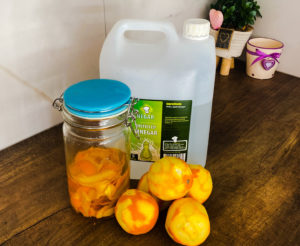
There were oranges in the back of a drawer in the fridge for, let’s say, a while. Not appetising but not covered in mould and ready to walk out on its own. I juiced them and froze the juice to use in baking another day.
Peeling the oranges, keeping mostly just the outer peel with all that lovely smelling orange oil, I put it in a mason jar and covered all the peel in white vinegar before sealing the jar making it airtight.
I kept mine on a shaded part of the countertop, away from direct light but where I’d see it every day, reminding me to gently turn it. After two weeks, strain the liquid into a spray bottle and mix 1:1 with water and you’ll have a lovely scented eco-friendly, sanitising cleaner that has multiple uses around the kitchen. I particularly love it for cleaning inside the fridge where you don’t want chemicals coming into contact with your food.
Tip: Before you bin a lemon or lime, cut it in half, place it in a small dish of vinegar and microwave for two minutes. Once cooled use the mixture to wipe off the now loosened food splatters for a sparkling microwave.
Enter essential oils.
From an Ayurvedic perspective, everything we touch, inhale, ingest and metabolise through our senses has the potential to heal. Our bodies work well in tandem with nature, which can keep us in balance.
Caution: Essential oils are highly concentrated and potent. Pregnant women, diabetics and people with other medical conditions should consult with their doctor before using essential oils. An accredited aromatherapist will advise you on oils and solutions best suited to your needs.
Essential oils appear expensive but just a few drops go a long way. Don’t be tempted to overdo it – you can always add an extra drop or two if necessary. They retain their properties best when kept away from sunlight and stored in dark glass. I found that the spray pumps I was repurposing didn’t function properly after a while and had to be disposed of. The white plastic of the bottles wasn’t suitable for essential oils either.
I found an Irish aromatherapy supplier (i.e. don’t always default to Amazon – buying from small businesses reduces your carbon footprint and aids the circular economy) that supplied both brown glass battles, the oils and Castile soap and I got to brewing my potions.
The favourites
Eucalyptus
Lavender
Lemongrass
Lemon
Lime
Orange
Geranium
Jasmine
Antifungal, antiviral, antibacterial
Eucalyptus
Lavender
Lemon
Grease remover, including soap scum on bathtubs
Eucalyptus
Lime
Lemon
For an antibacterial effect, hot water and a freshly made mixture are best.
I’ve also stopped using antibacterial sprays, which I used to spray and let air dry on surfaces after I’d cleaned them. While they kill good and bad bacteria the resistant bacteria – that 1% learn with repeated use of the spray to multiply.
For me, it’s still a learning curve and at times it can feel a bit daunting about what can be mixed with what. But a quick internet search will get you your answer if you click through to known, trusted websites such as WebMD and Healthline
Always label your bottles after you mix them. I have one bottle of Castile soap (1/4 soap 3/4 water) with about 20 drops of mixed essential oils and another with the same volume but with vinegar, instead of the soap. The soap and vinegar don’t mix well together and can leave residue but you can use the soap first then a spritz of vinegar mixed with water. Also, don’t mix your natural blends with other cleaning products, such as bleach, as it can release toxic gases.
If you’ve any comments or read more articles like this I’d love to hear from you. Happy Cleaning
PS: The Before
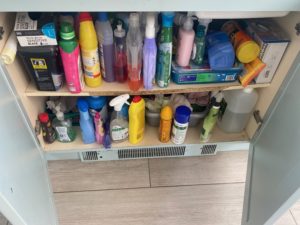

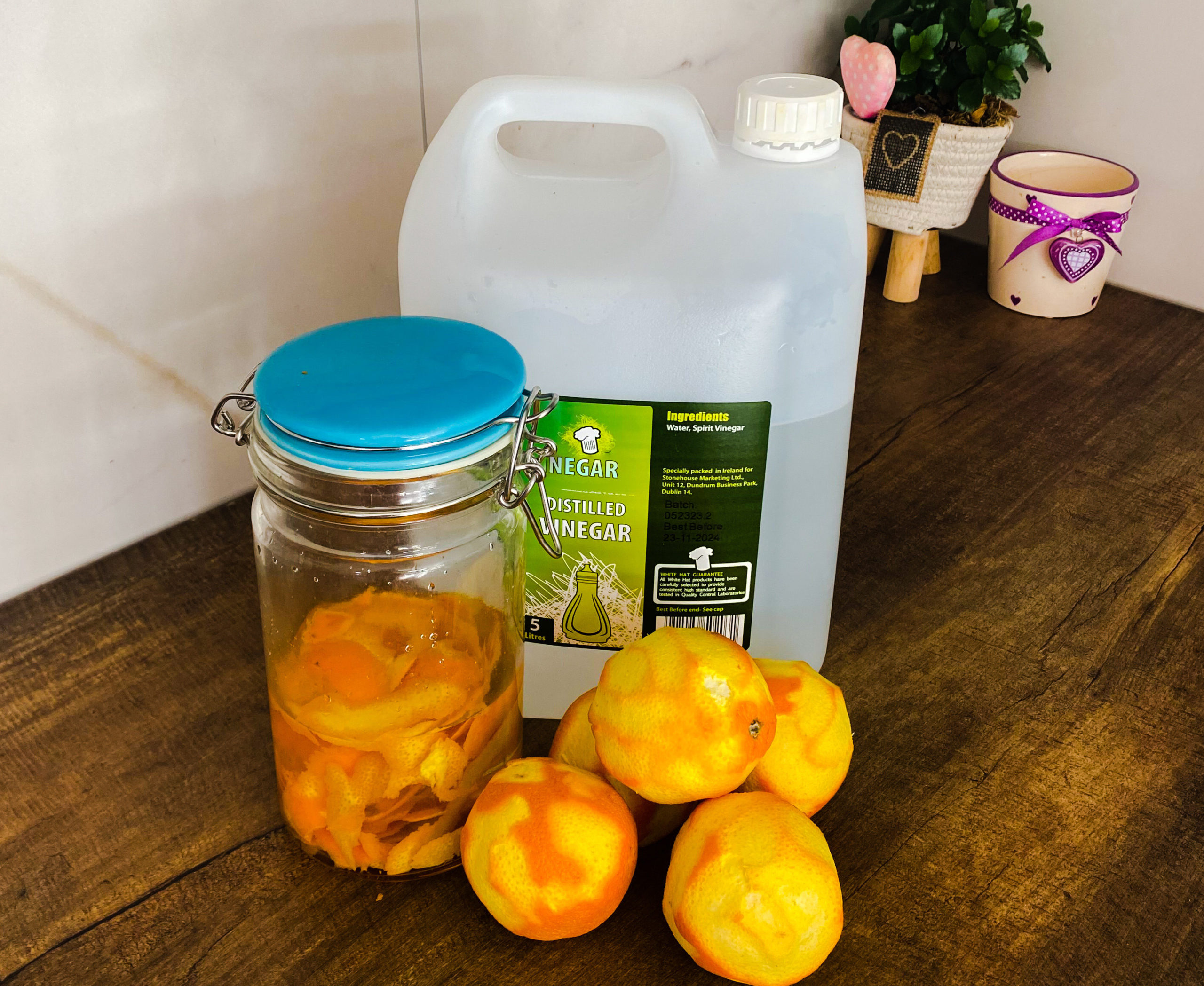
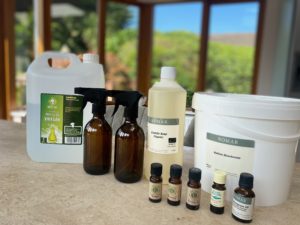
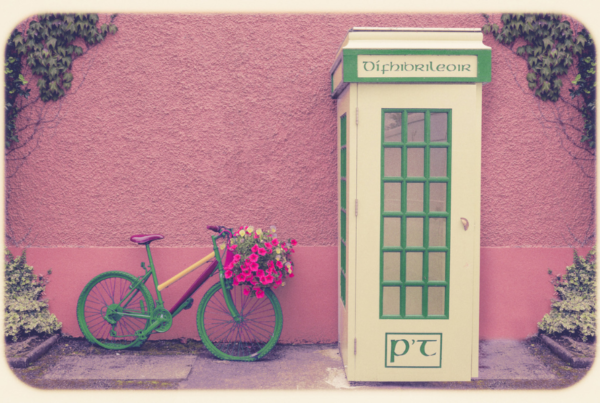

Recent Comments